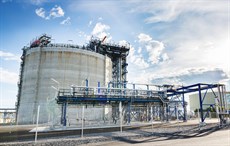Woodside expects LNG prices to remain high for next few years
(Reuters) - Woodside Energy Group, Australia's top independent natural gas producer, sees LNG prices staying high for a few years as the market adjusts to supply disruptions after sanctions on Russia for its Ukraine invasion.

"With the invasion, we are seeing the world try to move away from Russian hydrocarbons and that means that demand for LNG from places like Australia is up," Woodside Chief Executive Meg O'Neill said.
"We do expect ... prices to remain elevated for the next year, perhaps next few years as the world tries to rebalance gas in supply and demand," she told reporters on the sidelines of the World Gas Conference.
The global LNG market was already tight before the invasion because of underinvestment in the past five years, O'Neill said. "We took an investment decision last year on our Scarborough project, but those volumes aren't going to come into the market until 2026 so there is a period that I think things will continue to be tight."
Woodside owns 100% of the Scarborough project following its merger with BHP Group's petroleum arm. O'Neill said last week that Woodside has received strong interest from companies for a stake in the project.
Too boost its overall supply portfolio globally to meet the rising LNG demand, Woodside is keen to grow its position in the United States, O'Neill said.
Earlier this year, Woodside signed an agreement with Commonwealth LNG to secure 2 MMtpy of LNG supply from Commonwealth's proposed liquefaction plant in Louisiana. The company already has a 20-year deal with Cheniere for supply from its Corpus Christi, Texas, plant.
"We are interested in additional U.S. offtake, one of the things we've realized and we've seen over the last 10 years is the LNG industry has grown tremendously in the Atlantic basin," O'Neil said.
But, Woodside will continue to exit from the Kitimat LNG project on Canada's Pacific coast, though it will keep its stake in the Liard Basin gas resource in Western Canada, she said.
"It's a very big gas resource and we are optimistic that we may be able to find a way to commercialize that either as a gas development or perhaps feeding into an ammonia development," O'Neill said.
Following the BHP merger, the company is evaluating its exposure to oil and gas prices as it picks up more oil production, O'Neill said.
"We've got an opportunity to really design what kind of revenue risk we want to take," she said.
This year, Woodside expects to sell up to 25% of its LNG using gas benchmarks such as the Japan-Korea Marker (JKM) in Asia, the Netherlands' TTF price for Europe, and the UK’s National Balancing Point, while the rest is sold on long-term contracts linked to global oil prices.
Gas prices tend to move higher during summer and winter while oil prices are quite stable throughout the year, she said.
(Reporting by Florence Tan; Additional reporting by Sonali Paul; Editing by Himani Sarkar, Richard Pullin and Christian Schmollinger)

- ADNOC Gas awards $2.1 B in contracts to enhance LNG supply infrastructure
- U.S. Department of the Treasury releases final rules for clean hydrogen production tax credit
- Tecnimont to build waste-to-biogas plant to fuel local kitchens in India
- Indonesia regulator confirms disruption at bp's Tangguh LNG project
- Topsoe, Aramco sign JDA to advance low-carbon hydrogen solutions using eREACT™



Comments